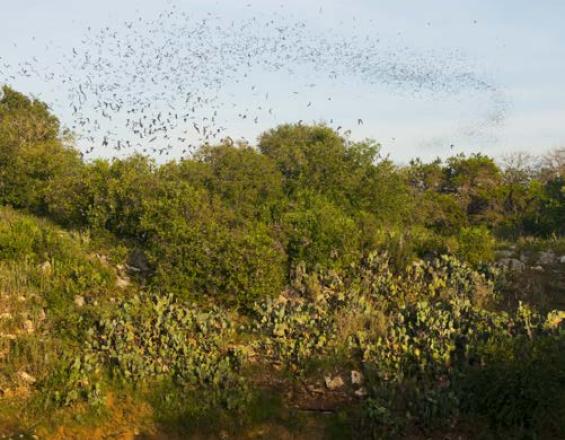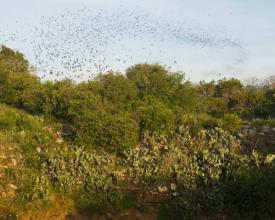
Bracken Cave Preserve Established Through One Health Assessment

The Bracken Cave Preserve is home to the largest bat colony in the world, an estimated 20 million Mexican free-tailed bats (Tadarida brasiliensis). Plans to construct a residential complex along the 1,521-acre tract adjacent to the cave mouth posed a serious risk to wildlife and the potential human population. Motivated by concerns for a nearby aquifer, but limited by a lack of zoning laws in the area, the local government commissioned a report on the potential public health risks of the development. The report outlined concerns for human exposure to various pathogens, from both exploring the cave and the bats’ presence around the new residences. To protect the bat and human populations, advocates from diverse sectors, including conservationists, health experts, city and county governments, and the public water utility, came together to purchase the tract of land. In 2014, the property was officially made into the Bracken Cave Preserve, protecting this area essential for environmental, animal, and human health in perpetuity.
Context
Challenges addressed
Before the team purchased the Galo tract to create a preservation, plans were in place to develop 3,500 units and a sprawling residential community. This would have resulted in substantial environmental alterations with cascading impacts on all of the surrounding wildlife, in particular the bat colony and the golden-cheeked warbler population. The human population would be exposed to various health risks through both the bats’ flights and the inevitable human exploration of the Bracken Cave. The development’s potential impact on a nearby aquifer presented additional environmental, social, and health challenges. The area of Texas in which the Galo tract is located has no zoning laws, giving the local jurisdictions no authority to step in and alter the development plans. Without a specific legal mechanism available to stop the residential development, the team determined that only by purchasing the land themselves could they prevent the negative environmental and health impacts of the development.
Location
Process
Summary of the process
When utilizing a One Health lens to approach any challenge it is essential to work effectively across previously siloed sectors. Human wellbeing is often not considered a part of conservation planning, and the ecosystem services provided by intact natural environments are often overlooked by the human health field. A One Health assessment creates an opportunity to bridge the gap and bring together stakeholders with diverse motivations and a shared goal. The partnership developed to purchase the Galo tract and create the Bracken Cave Preserve was made possible through a report specifically outlining the intersection of the bat colony’s presence and the health and wellbeing of surrounding human communities.
Building Blocks
Partnership Across Sectors
When it was announced that the Galo tract would be developed into a residential area it concerned parties from multiple sectors. Conservationists and bat scientists saw this plan as creating a human-wildlife conflict where there was not one previously, presenting threats to the health and wellbeing of both nature and the human populations. Local government, in particular City Council member Ron Nirenberg, had expressed concerns about the plan mainly focused on the nearby aquifer and the region’s drinking water. To fully assess the major trade-offs of the residential development plan, local government took the step of unifying diverse partners and their cross-cutting interests. By finding common ground in the end goal of preserving the area surrounding the Bracken Bat Cave, stakeholders from diverse sectors were able to transform their individual concerns into a large-scale mutual interest.
Enabling factors
Though the group of stakeholders that came together to purchase the Galo tract, including groups with previously conflicting interests, had separate motivations, their openness to collaboration allowed them to find common ground. By recognizing their mutual interest and identifying where their concerns intersected a partnership was developed and a shared goal was achieved.
Lesson learned
All stakeholders involved in this project had their own individual concerns with the residential development planned for the area surrounding the Bracken Bat Cave. While each issue, including but not limited to water safety, wildlife conservation, and human health risks, was troubling in and of itself, no lone stakeholder could create a strong enough case to prevent the development from moving forward. The local government recognized the value in collaboration and created a space for previously siloed sectors to come together. By developing partnerships where there were previously gaps, particularly between the environmental and human health sectors, the larger solution of purchasing the land and creating a preservation was made possible.
One Health Assessment
To fully capture the intersecting health risks that the residential development of the land surrounding the cave would result in, a One Health assessment, an in-depth look at the intrinsic connections between the health of humans, animals, and the environment in the area, was carried out. Lead by EcoHealth Alliance, it highlighted the bats’ ecology and interactions with their environment, calling attention to the uniqueness of this colony and the various ways in which they would overlap with human residences. This report was utilized to mobilize a large coalition of concerned stakeholders – by shining a light on the risks humans would be facing, previously uninvested individuals were now joining the effort to prevent the development from moving forward. A One Health approach expanded the potential audience, generating more attention and funds, leading to success where a siloed approach would have failed.
Enabling factors
A successful One Health Assessment was made possible by the expansion of concern beyond the issues captured in the standard assessment carried out for development. Siloed stakeholders were focused on human, animal, or environmental safety, but the recognition that these issues were stronger when considered together allowed a more comprehensive evaluation to take place.
Lesson learned
Expanding the traditional impact assessment to include a One Health lens allows a more comprehensive understanding of both the potential risks a development poses, and the potential gains of preserving the land. When a natural system (and the wildlife it is home to) does not have enough social or financial value in and of itself to prevent human encroachment, highlighting the human health protections it provides may grant it the additional value needed to gain protection. The One Health approach calls attention to ecosystem services that have previously gone unrecognized such as disease regulation and spillover risk reduction. Additional services bats provide, such as pollination, seed dispersal, and vector control, provide further human health benefits that can also be factored into future assessments. A larger and more diverse group of stakeholders invested in protecting nature makes conservation efforts more achievable and successful.
Impacts
The impact of this solution goes beyond just wildlife conservation and captures the diverse positive effects of a One Health approach in land development planning. The wildlife of the region, including the 20 million bats living in Bracken Cave and the federally endangered golden-cheeked warbler (Setophaga chrysoparia), now live under protection from encroaching human populations. Conservation nonprofits are ecologically managing the region through efforts including controlled burns, ensuring the greater ecosystem’s health. As 3,500 units were prevented from being built along the Galo tract, tens of thousands of potential human residents were protected from the unavoidable exposure to pathogens circulating within the bat population. As demonstrated by the effects of previous spillover events, including SARS, Zika, and COVID-19, the protection to human health provided by the Bracken Cave Preserve is not limited to the individuals who would have lived within the bats’ flight path. Communities as close as next door to potentially as far as the other side of the world have avoided the consequences of a zoonotic disease jumping from the bat population to people.
Beneficiaries
The health and well-being of surrounding human communities
Mexican free-tailed bat colony
Golden-cheeked warbler population
Surrounding ecosystem
Sustainable Development Goals
Story
Traditional environmental impact assessments typically don’t examine risks of zoonotic disease transmission that may result from increased human-wildlife contact created by the development project. The environmental and health impact assessment initiated by the City of San Antonio, in response to a plan to create a residential neighborhood on land adjacent to Bracken Cave, was truly remarkable in that, to my knowledge, it was one of the first instances of a local municipality moving beyond traditional environmental impact assessments by commissioning a study of potential health impacts from zoonotic diseases that would result from the development. Specifically, the city health department wanted to know whether there would be an increased risk of exposure to zoonotic pathogens, such as rabies, as a result of contact with bats or other wildlife that live in and around the cave. Bracken Cave is home to the world’s largest colony of bats. These bats are ecologically and economically important because they consume tons of insects that are agricultural pests. Bats are also reservoirs for rabies virus, which is fatal in people, as well as dogs and cats, when unvaccinated. I appreciated that in addition to the health questions I was brought in to answer, the City of San Antonio was also working with a local bat conservation organization and other environmental organizations to develop a complete understanding of the potential threats to local wildlife. To me, this was a terrific example of One Health science and policy in action. After spending time observing the flight patterns of the bats and interviewing residents from existing communities near the cave, it became clear to me that that there would be substantial opportunities for people and their pets to have contact not only with bats but also other animals like raccoons, skunk and foxes that preyed on the bats at the mouth of the cave and that also carry rabies. The combination of the conservation, environmental and health impact assessments undertaken by the city provided important evidence that the development was problematic. Bat Conservation International and Conservation International’s ability to raise money and buy the land outright to protect it from development was certainly a win for conservation and public health. To me, the City of San Antonio’s initiative to consider health consequences of increased human-wildlife contact was a win for One Health and a model approach for development globally.



